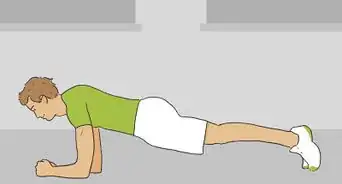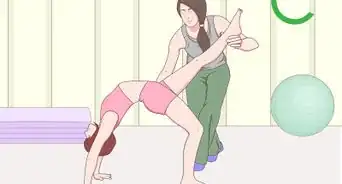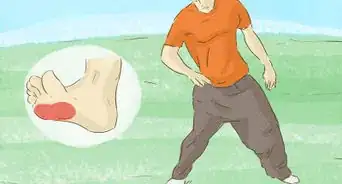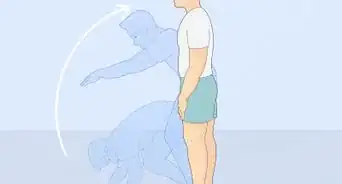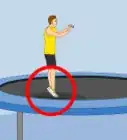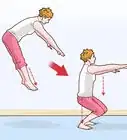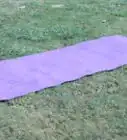X
wikiHow is a “wiki,” similar to Wikipedia, which means that many of our articles are co-written by multiple authors. To create this article, 17 people, some anonymous, worked to edit and improve it over time.
This article has been viewed 51,948 times.
Learn more...
A backflip off a wall is a staple of many martial arts action sequences. The trick looks cool when done correctly, and despite how difficult it may look, many people find them easier to perform than a regular standing backflip. With some practice and the proper safety precautions, you can learn to backflip off a wall.
Steps
Part 1
Part 1 of 4:
Practicing Before Trying to Backflip off a Wall
-
1Practice doing backflips that don't require a wall. Running at a wall can make doing the backflip more daunting even if the wall does help boost you off the ground. You may be more comfortable backflipping off a wall if you already knows how to backflip elsewhere. You can try How to Backflip on a Trampoline and How to Do a Backflip first if you feel like you need to build up to backflipping off a wall.
- Another plus of backflipping in place or on a trampoline is that it's easier to incorporate a safety mat, which reduces the risk of injury.
-
2Consider having a coach or spotter help with your form. Fitness and gymnastics instructors alike are both used to helping people perfect their form and avoid injury. A coach of spotter can help you learn how to backflip in a variety of ways.
- Initially, a coach may help you practice jumping with a slight backward rotation while standing behind you to stop you from actually turning over. This is also a great way to help you practice jumping while tucking your knees without actually flipping.[1]
- As you advance in the process, a coach can help with your backflip form by placing one hand on your lower back and another on the back of your thigh. When you actually backflip, the back hand helps act as a fulcrum for you to rotate around and the thigh hand will push up and over to help give you momentum.[2] The coach/spotter will gradually apply less force and let you do more of the work.
Advertisement -
3Try performing the trick onto a landing mat. One of the best ways to practice backflipping off a wall safely is to land on a few stacked landing mats. Instead of running straight at the wall, approach at a 45-degree angle. Place the landing mats immediately beside the point where you will launch off the wall. The angle and the launch will propel you over the landing mats to land. This allows you to practice getting the flip motion while being able to land on your knees or butt without the risk of injury.[3]
- Once you can land on your feet on the mats, which are stacked higher than the floor, you will have more confidence in your ability to make the full backflip when you try it without them.
Advertisement
Part 2
Part 2 of 4:
Approaching the Wall
-
1Check your surroundings. Make sure all surfaces are dry and that you can get traction on the wall. If possible, you should also consider placing down a gymnastics mat to help your landing while you practice.
-
2Practice running up to the wall. Your approach to the wall is very important since it fuels your momentum through the entire flip. Practice running up to the wall several times and get an idea of the best placement for your final step before you plant your foot on the wall based on your personal stride.
- You don’t actually need to run full speed at the wall. Think of the wall as a launch ramp. Too much forward momentum toward the wall will make it difficult to transfer that motion upward and into the flip.[4]
-
3Make sure your last step is with your non-dominant leg. Since your dominant leg will offer the most power to plant on the wall and push off it, you want the last step before reaching the wall to be on your non-dominant leg.[5]
- If during any of your practice rounds, you reach the wall on the wrong foot, stop and start over.
-
4Jump from your non-dominant foot toward the wall. Since you need to transfer your forward momentum toward the wall into upward momentum off the wall, don’t take a standard forward stride on the final step. Instead, give a small jump or hop that allows you to plant your dominant foot higher on the wall, which will give you more height and clearance for the flip.[6]
Advertisement
Part 3
Part 3 of 4:
Planting on the Wall
-
1Plant the toes of your dominant foot on the wall. You want the toes of your dominant foot to contact the wall and create your source of traction to push off.[7]
-
2Keep your shin as vertical as possible. When you push off the wall, you want to be able to push both up and out. To achieve this, you want to have the shin on your dominant leg as close to vertical as possible.[8]
- By pushing up and out, you give yourself more height off the wall and more distance away from it to complete your backflip.
- If your shin is closer to horizontal, then your foot will be flat against the wall, which means you’ll only push yourself out and not up. This is dangerous and a good way to hit your head.[9]
- If the top of your shin is angled too far toward the wall instead of up, your toes won’t get traction on the wall, which can easily cause your foot to slip off and result in your simply colliding with the wall.[10]
-
3Push up and off the wall with your toes. Giving yourself both upward and backward momentum off the wall is the key to starting the backflip successfully. You want to launch off the wall at close to an upward 45-degree angle rather than simply pushing yourself backward off it.[11]
-
4Practice jumping off the wall. Without actually rotating into a backflip, practice every other step so far. Run up to the wall with your feet planted properly, contact the wall with the toes on your dominant foot, and use the contact force to spring up and back at a 45-degree angle. Once you feel comfortable with this, you can try adding in the backflip.
Advertisement
Part 4
Part 4 of 4:
Flipping off the Wall
-
1Swing your arms up. As you plant your foot on the wall, start to bring your arms up. You want them to be in full swing by the time you push off in order to provide more momentum into the backflip.[12]
- You want your elbows crooked at about a 90-degree angle rather than having your arms straight out. If your arms are straight, you can very easily slam your fists into the wall as you swing your arms up over your head.[13]
-
2Kick your non-dominant leg up and over. Just after you push off the wall, kick the other leg up and over to help give you full rotational momentum. Combined with your swinging arms, this will deliver enough force to bring you fully around.[14]
-
3Bring your legs up into a tucked position. Much like a figure skater tucking her arms in to gain rotational speed in a spin, you want to tuck your body to help backflip with the least resistance. This means that as you follow through with the kick motion, you want to bring both legs up as though you were crouching in air during your backflip.[15]
-
4Try to keep your eyes on one spot on the wall. You will be tempted to crane your head and neck back to follow the trajectory of your spin, but this will cause your upper body to stretch out rather than tuck into a ball. Instead, try to keep your eyes trained on the wall as your legs come around and tuck into the ball.[16] By looking forward, you ensure that you end up with the most rotational speed possible.
- Since your head is roughly at the center of the fulcrum, it will actually be the last thing to spin, and it will whip around the fastest after all the rest of the inertia is going.
-
5Open up once you see the wall again. As your legs and hips come up and over, they will block your view of the wall, but as your body comes fully around and your keep your head vertically oriented, you will regain a visual with the wall. This is when it’s time to open your body and slow yourself to land.[17]
-
6Push your knees down toward the ground. Once you have come fully around and can see the wall in front of you again, push your knees down toward the ground. This will decelerate you as well as getting your feet down to land.[18]
- Your knees will still be slightly bent when you put them back under you. If you just straighten your legs completely, they will end up too far ahead of you. This can result in you landing on your heels, which will make you stumble backward and potentially fall.[19]
-
7Keep your feet apart as you land. If you land with your feet together, you are much more likely to land off-balance and stumble. Keep your feet apart to give yourself a larger center of gravity.
Advertisement
Community Q&A
-
QuestionIf I'm overweight, can I still do a backflip?
 Community AnswerIt depends how much muscle you have and how agile you are, I would recommend you try it on a trampoline first or with a trainer. Do't try it on the grass or ground until you've practiced it a lot.
Community AnswerIt depends how much muscle you have and how agile you are, I would recommend you try it on a trampoline first or with a trainer. Do't try it on the grass or ground until you've practiced it a lot. -
QuestionCan I do a backflip if I have no experience in gymnastics and have low stamina?
 Community AnswerYou can, but it's best to try it on a trampoline first. This will be easier and safer. If you make an effort to be more active, your stamina will likely increase, so give it a try and if it doesn't come to you right away, practice!
Community AnswerYou can, but it's best to try it on a trampoline first. This will be easier and safer. If you make an effort to be more active, your stamina will likely increase, so give it a try and if it doesn't come to you right away, practice! -
QuestionCan you do it off a wardrobe?
 Community AnswerNo. Never do it off of a wardrobe as it can become very unstable and fall on top of you. Only use a wall or stable objects.
Community AnswerNo. Never do it off of a wardrobe as it can become very unstable and fall on top of you. Only use a wall or stable objects.
Advertisement
Warnings
- Do not try if you don't feel confident enough because injuries could be fatal.⧼thumbs_response⧽
Advertisement
References
- ↑ https://www.youtube.com/watch?v=Xv6PvH8hVKE
- ↑ https://www.youtube.com/watch?v=Xv6PvH8hVKE
- ↑ https://www.youtube.com/watch?v=7B-rxzMbNSo
- ↑ https://www.youtube.com/watch?v=LqytI1p8qew
- ↑ https://www.youtube.com/watch?v=LqytI1p8qew
- ↑ https://www.youtube.com/watch?v=LqytI1p8qew
- ↑ https://www.youtube.com/watch?v=LqytI1p8qew
- ↑ https://www.youtube.com/watch?v=LqytI1p8qew
- ↑ https://www.youtube.com/watch?v=LqytI1p8qew
- ↑ https://www.youtube.com/watch?v=LqytI1p8qew
- ↑ https://www.youtube.com/watch?v=LqytI1p8qew
- ↑ https://www.youtube.com/watch?v=LqytI1p8qew
- ↑ https://www.youtube.com/watch?v=LqytI1p8qew
- ↑ https://www.youtube.com/watch?v=LqytI1p8qew
- ↑ https://www.youtube.com/watch?v=LqytI1p8qew
- ↑ https://www.youtube.com/watch?v=LqytI1p8qew
- ↑ https://www.youtube.com/watch?v=LqytI1p8qew
- ↑ https://www.youtube.com/watch?v=LqytI1p8qew
- ↑ https://www.youtube.com/watch?v=LqytI1p8qew
About This Article
Advertisement
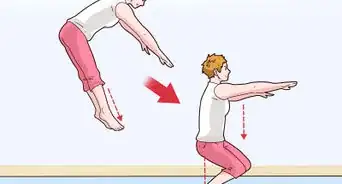

-Step-14-Version-2.webp)
